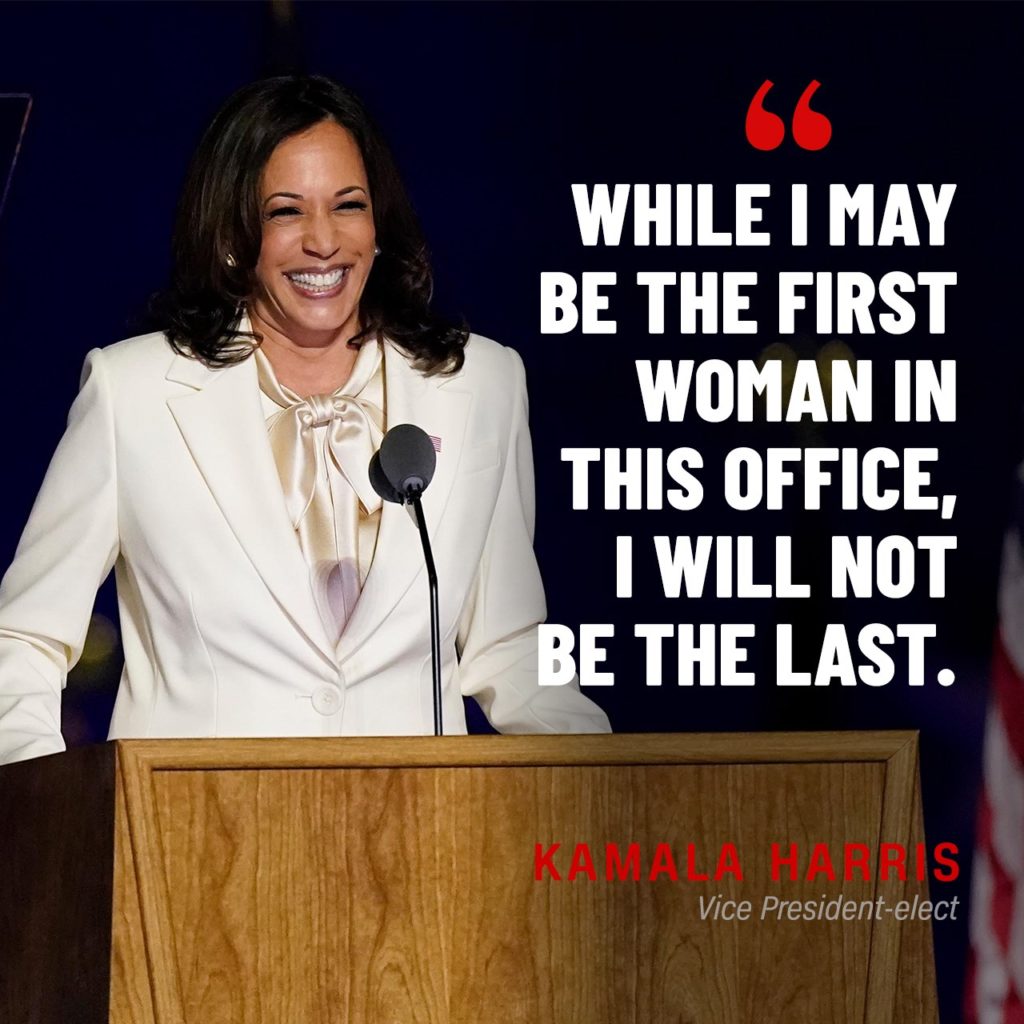
Is a speech you need to give looming over you? Guess what – you are in luck! Many people never even get a chance to be heard. If you have doubts about delivering a great speech, let’s turn to those who know and learn directly from them in this article.
Kamala Harris has taken the world by storm, making history by being the first Indian and black woman US Vice President-elect. You’ve probably heard of her famous “I am speaking“ phrase from the presidential campaign debate with Mike Pence. The style of that debate deserves a separate analysis to itself, as it was full of intrusions, manipulations, and other elements of ‘scandal talk’ tactics. She remained calm and collected, yet passionate, and reacted with grace and arguments to Mike Pence’s deliberate interruptions.
From “I am speaking” to “I am in charge,” less than a month passed. I find this to be one of the most symbolic displays of the power of public speaking.
The habit of sending iconic messages continued with Kamala’s great speech delivered in her public address just two weeks ago.
Use a persuasive speech as a great learning example
While this political topic is very popular right now, this article’s goal is not to analyze the agendas. Political speeches tend to get much attention, especially if they are done well. They can be used as examples of how to write a persuasive speech and deliver it. The tips presented here work for any moving speech that you might want to create – for your college work arguing for a cause, when receiving a work promotion, at your best friend’s wedding, or some other important moment in your life.
Here are 10 things we can learn from Kamala Harris’s approach on how to write a persuasive speech for any occasion and deliver it with impact.
1. Start With A Broad Topic That Unites
Kamala started her speech with the topic of democracy, which unites the political left, right, and all sexes and races. Although, some may argue -severely troubled, American democracy is still a shared ideal that unifies. She could have chosen to talk about the Democratic party that won, but given that many didn’t vote for Biden per se, but against Trump, that would have been a division point. Instead, she focused on the fact that ‘they all’ had to fight for democracy by protecting and exercising their right to vote.
Learning tip:
Of all the topics that may matter in your speech, choose the one your audience can identify with (even if they come from two opposing sides). Create a good unifying story around it. If you have access to data about your audience, by all means- use it to derive conclusions on how to tell your story.
2. You, not me.
In the first two minutes, the entire speech’s focus shifted to the audience. And who protected and won democracy back? You did. All of a sudden, we became the heroes! A great and uplifting twist that had people feel their votes and decisions were paramount. In other words, Kamala skillfully avoided giving herself or Biden much credit.
Where’s the learning?
Talk about what is essential to your audience. What’s in it for them comes before what’s in it for you? How are they or their needs the heroes of your story?
3. All Women (and women like you and me).
A possibility of an even more particular level of identification opens when you talk to a specific group that you represent. In Kamala’s speech, all women were singled out as essential for the outcome of these elections. To be even more specific, she gave black women the spotlight. This approach was right on point as it meant acknowledging grassroots activists’ efforts and the BLM movement.
Why is this important?
A woman in power acknowledging her fellow women amplifies the message. Like any group with a shared background, it creates a feeling of belonging and deep understanding. It tells about the sisterhood, the power of united effort, and bonding that women need to feel empowered. This is how you engage and win over (at least) 50% of your audience.
4. I am standing on the shoulders of giants.
Kamala started her speech with a quote from John Lewis. Her next memorable mention was her mother. During her speech, she made sure to talk more about the people who made her success possible. Throughout her persuasive speech, Kamala made everything, not about her.
The learning here is – use the wisdom that came before you, and show that you are continuing that line. Recognizing giants will give your story more authority, as you will appear knowledgeable and as someone walking a powerful path.
5. Behold the power of humility.
There was a tactic of claiming authorship in the old Christian writings yet remaining humble and behind the curtain. The authors did it by saying that God has spoken through them. Also, from ancient times on, great speakers and authors represented themselves as a medium for the divine message. In Kamala’s speech, even the things directly about her were put in the form of a powerful message – I have great predecessors, and I am merely opening doors to more people to come after me.
The take out –
Whatever the approach you like, be it the self-deprecating humor or modesty, when you avoid talking about your achievements (the how great you do stuff) and show passion and a broader mission (the why you do it), it becomes a dignified human story that the audience starts to root for.
6. Imperfect (genuine) talk and reactions.
If you recall, the speech started a bit awkwardly. Kamala said, ‘Good evening’ at least five times! However, it was a genuine reaction to the outpour of joy, screams, and honks she was greeted with. A similar reaction was her grin when mentioning her husband and the love she has for him. She also made sure to mention the loss Biden has experienced and the tragedies of many families during the coronavirus pandemic. There was a brief moment of silence and an emotional gasp when mentioning her late mother.
What’s the learning?
Vulnerability and imperfection are authentic. When you act spontaneously, it sends a message of comfort and confidence. Being emotional and honest (at emotional points in the speech) is what the audience picks up instantly. We are not talking about train-of-thought random blurts that some people call spontaneous. The best way to come across as natural on stage is to practice your speech for days, weeks, even months.
7. Emotional yet steady.
Kamala’s tone for this rather ‘official’ speech was emotional and warm. This approach is a trait of a good mentor or a leader. You do not want to appear too soft, yet you want to avoid being too harsh and alienating. You want a fine line that gives a feeling that the audience can trust you since you share their emotions and experience them yourself. At the same time, you provide steady guidance by clarifying what you are planning to do.
What is the learning here? There are an undeniable charisma and confidence that come with walking the talk. When you are living and doing it, your speech will flow more easily. Choosing a topic you are passionate about and experienced in will let you avoid the trap of needing to prove yourself in a ‘big talk’ and give space for simplicity and connection.
8. The bad-mouthing is a thing of the past.
Contrary to the scandal-talk practice of hating (or trashing) everyone, even one bit different than us, there was no bad word for opponents in this speech. We are witnessing an important shift in communication style – instead of creating flammable divisions, Kamala was looking for common ground in her speech.
What’s the learning here?
When you talk about your competition, acknowledge the things you share, but emphasize what makes your point unique and valuable. If you admire or have learned from your opponent, say that! When Mike Jagger was inducting the Beatles into the Rock n Roll Hall of Fame, he was pretty honest and said that back when they were beginning, the Rolling Stones were a bit jealous (and sick) about the Beatles doing it so well!
9. The story structure is an emotional guide.
There is a great thing about our perception, and it has been proven that we might forget what was said, but we rarely forget how it made us feel. Instead of selling a political agenda, Kamala was letting us feel the moment. When talking about opening doors to other women, I am sure that every woman got a teary eye (we even saw them in the audience during the broadcast) and remembered every time she was bullied, denied, or put down in her school or workplace. But for that one moment, she felt heard, and all of her efforts made sense.
What is the takeout?
Instead of shallow marketing promotion, you are sharing your truth and creating stories around it. Stories are connecting on an empathy level: I see you. I know how you feel because I was there, too. That is a compelling call for your audience to follow you on your story path.
10. Create memorable phrases.
Ask yourself: What is the single sentence that I would like to leave my audience with? In this speech, Kamala created an iconic sentence that flooded social media almost immediately: While I might be the first one in this office, I will not be the last! Not only was she saying that her time has come, but her message is also – I am already building a legacy.
Why is this important –
Bite-sized wisdom has a long life on social media. And the more historic the subject, or the moment for that subject, the bigger it grows. Here is another proof: The phrase ‘I am speaking’ from the debate immediately became a symbol of the women’s struggle to voice their opinion and be heard in the patriarchal stronghold that still rules many workplaces and, in this case – governmental politics.

While having to speak in front of people makes even the best speakers nervous, creating and preparing for a good speech does not have to be. I suggest you take a step back, look at your bigger picture, and write the speech as a story with these tips in mind.
Here are the 10 tips from Kamala Harris’ speech, in summary:
1. Start with a broad topic that unites audiences
2. You, not me. What is in it for them? – broad identification
3. All women (and women like you and me) – particular identification
4. I am standing on the shoulders of giants – acknowledge your predecessors
5. Behold the power of humility – put it in a broader vision
6. Imperfect (genuine) talk and reactions – when you are well-prepared, you can react naturally
7. Emotional yet steady – comforting and encouraging
8. Avoid bad-mouthing – you can learn from your competition
9. Create the story structure as an emotional guide for the audience.
10. Create memorable phrases – they have a long life in the media
You can also read the transcript of her speech in full.
A final note is on improvement – we can turn the fear of public speaking into gratitude by changing our attitude.
(Oh, it also rhymes).
There is beauty in being chosen to talk about what you think matters and great power in being heard. The quarantine can be a good time to learn a new skill. Let me know if I can help with your next speech or if you would be interested in online classes in public speaking and/or pitching.
